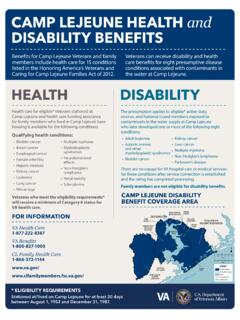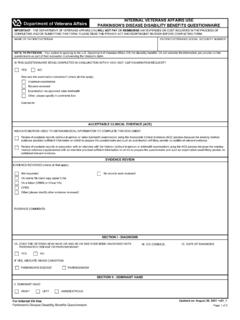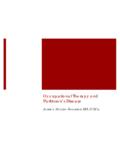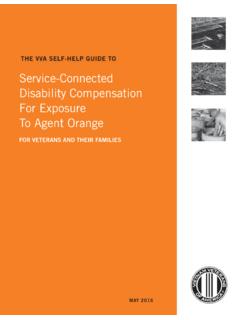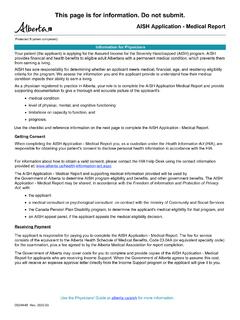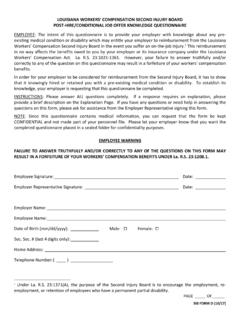Transcription of 3. The Global Burden of Disease concept
1 The Global Burden of Disease concept273. The Global Burden of Disease GBD concept , first published in 1996, constituted the most comprehensive andconsistent set of estimates of mortality and morbidity yet produced (Murray & Lopez,1996), and WHO now regularly develops GBD estimates at regional and Global level fora set of more than 135 causes of Disease and injury (Mathers et al., 2002; WHO, 2002a). A GBD study aims to quantify the Burden of premature mortality and disability for majordiseases or Disease groups, and uses a summary measure of population health, the DALY,to combine estimates of the years of life lost and years lived with disabilities. The data arealso broken down by age, sex and also supports NBD studies to obtain country-specific estimates for input to nationalpolicy.
2 The national studies are based on the GBD concept and the data can be used inEBD assessments to estimate the contributions that environmental risk factors make to theoverall Disease Burden . Over 30 countries are now undertaking NBD studies. Guidelines,software tools, and data for NBD studies are available from WHO (Mathers et al., 2001). measures of population healthSummary measures of population health measure the health of a population by combiningdata on mortality and non-fatal health outcomes into a single number. Besides the DALY,several other such measures have been devised, including the Quality-Adjusted Life Year(QALY), the disability -Adjusted Life Expectancy (DALE) and the Healthy Life Year(HeaLY) (Weinstein & Stason, 1977; Murray & Lopez, 1996; Hyder, Rotllant & Morrow,1998; Murray, Salomon & Mathers, 2000).
3 The benefits and challenges of these measureshave been examined (Anand & Hanson, 1997; Williams, 1999; Murray & Lopez, 1999b,Murray, Salomon & Mathers, 2000; Murray et al., 2002). As the DALY has been the mostwidely-used measure, and can be applied across cultures, we will focus on it in this DALY measures health gaps as opposed to health expectancies. It measures thedifference between a current situation and an ideal situation where everyone lives up to theage of the standard life expectancy, and in perfect health. Based on life tables, the standardlife expectancy at birth is set at 80 years for men and for DALY combines in one measure the time lived with disability and the time lost dueto premature mortality:DALY = YLL + YLDThe YLL metric essentially corresponds to the number of deaths multiplied by the standardlife expectancy at the age at which death occurs, and it can be rated according to socialpreferences (see below).
4 The basic formula for calculating the YLL for a given cause, ageor sex, is:where:YLL = years of life lost due to premature = years lived with Global Burden of Disease concept28 YLL = N x LThe DALY is based on the premise that the best approach for measuring the Burden ofdisease is to use units of time. Having chosen units of time as the unit of measure, theburden of Disease can still be calculated using incidence or prevalence measures. Time lostdue to premature mortality is a function of the death rate and the duration of life lost dueto a death at each age. Because death rates are incidence rates, there is no obviousalternative for mortality than to use an incidence perspective. By contrast, for non-fatalhealth outcomes, both incidence and prevalence measures have been routinely used.
5 Thus,it is possible to calculate the number of healthy years of life lost because of people livingin Disease states, in terms of prevalent cases of Disease in the population in the year ofinterest, or in terms of the incident stream of healthy years of life lost into the future forincident cases of the Disease in the year of noted above, the DALY measures the gap between the actual health status of apopulation and some ideal or reference status, using time as the measure. In developingthe DALY indicator, Murray & Lopez (1996) identified two key value choices: how long should people in good health expect to live? how should we compare years of life lost through death, with years lived with poorhealth or disability of various levels of severity?
6 The first of these choices relates to the standard life expectancy used to calculate the YLL,and the second to the development of disability weights described in the following time lived with disabilityThere are at least two ways of measuring the aggregate time lived with a disability . Onemethod is to take point prevalence measures of disability , adjusting for seasonal variationif present, and express them as an annual prevalence. The alternative is to measure theincidence of disabilities and the average duration of each disability . The product of theincidence and the duration will then provide an estimate of the total time lived withdisability. This is the approach used for the estimate YLD on a population basis, the number of disability cases is multiplied by theaverage duration of the Disease and a weight factor that reflects the severity of the diseaseon a scale from 0 (perfect health) to 1 (dead).
7 The basic formula (without applying socialpreferences) for one disabling event is:YLD = I x DW x Lwhere:N = number of = standard life expectancy at age of death (in years).where:YLD= years lived with number of incident disability average duration of disability (years)The Global Burden of Disease concept29To use time as a common currency for non-fatal health states and for YLL, time must bedefined and measured for living in non-fatal health states. To place a value on the timelived in non-fatal health states, health state weights are used to formalize and quantifysocial preferences for different states of health. Depending on how these weights arederived, they are referred to as disability weights, QALY weights, health state valuations,health state preferences or health state utilities.
8 Most such weights are measured as anumber on a scale of 0-1, where 0 is assigned to a state comparable to death and 1 isassigned to a state of ideal health. This assignment for the QALY is inverted compared tothat used for the DALY (where 0 = perfect health and 1 = death), because the QALY measures equivalent healthy years lived, whereas the DALY measures loss of the disability weights used in DALY calculations quantify societal preferencesfor different health states, the weights do not represent the lived experience of anydisability or health state, or imply any societal value for the person in a disability or healthstate. Rather, they quantify societal preferences for health states in relation to the societalideal of good health.
9 Thus, a weight for paraplegia of does not mean that a person inthis health state is half dead , that they experience their life as halfway between life anddeath, or that society values them less as a person compared to healthy people. It meansthat, on average, society judges a year with blindness (weight ) to be preferable to ayear with paraplegia (weight ), and a year with paraplegia to be preferable to a yearwith unremitting unipolar major depression (weight ). It also means that, on average,society would prefer a person to have a year in good health followed by death, than a yearwith paraplegia followed by death. Society would also prefer a person to live three yearswith paraplegia followed by death (3 years x = lost healthy years), than have oneyear of good health followed by death (2 lost years of good health).
10 Following the GBD terminology, and consistent with the WHO International Classificationof Functioning, disability and Health (ICF), the term disability is used broadly in BoDanalyses to refer to departures from good or ideal health in any of the important domainsof health. These include mobility, self-care, participation in usual activities, pain anddiscomfort, anxiety and depression, and cognitive impairment. In some contexts, health is understood to mean absence of illness , but in the context of summary measures ofpopulation health, health is given a broader meaning. As well as implying the absence ofillness, it also means that there are no impairments or functional limitations due to previousillness or injury. Note that disability ( a state other than ideal health) may be short-termor long-term.










